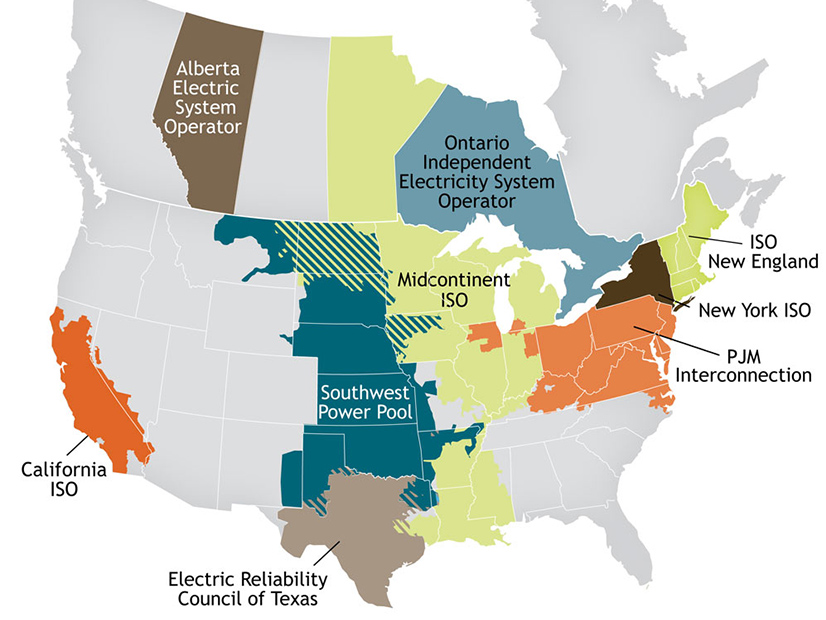Nine former FERC members urged the commission Wednesday to push for organized power markets in all regions of the country, including the West and Southeast.
A letter signed by nine past commissioners and chairs said FERC should employ its “broad authorities and tools available under the Federal Power Act” to create RTOs and ISOs in areas not currently supported by organized power markets, saying it would provide consumer benefits and help integration of renewable energy.
The bipartisan list of FERC officials spanning more than three decades of public service said consumers in regions not serviced by an RTO or ISO are missing out on benefits seen in regions with organized markets, and that markets are “more essential than ever” as the power sector continues to decarbonize.
“As the pace of decarbonizing the grid accelerates, we are convinced that the time for organized market expansion is now,” they said. “We recommend that FERC get ahead of the curve by getting the basic foundations in place everywhere. Promoting the expansion of organized wholesale markets now ensures that the grid is a powerful enabler of our clean electricity future.”
They said RTOs and ISOs have proven the ability to attract clean energy investment and are a critical component in implementing new technologies to reach a goal of “clean, reliable and affordable electricity for our entire nation.” Changing customer preferences, the “broad electrification” of the economy, reduced costs for clean energy technologies and “climate-related grid emergencies” are all driving issues for FERC to address.
FERC for two decades has pushed organized wholesale markets to “ensure a well functioning and dynamic grid,” the former commissioners said. Initiatives currently underway in the West and Southeast to develop wholesale markets should be encouraged. (See Study: Southeast RTO Would Cut Rates, Emissions.)
They cited several features they said allow organized wholesale markets to provide a “customer-centric transition” to a cleaner grid at the least cost, including larger footprints that can incorporate renewables, “level playing fields” for power providers and “non-discriminatory grid access.”
“To prepare the grid for a rapid evolution toward the low-carbon future, we urge you to finish the job of setting up organized wholesale power markets and ensure that they flourish in all regions of the country,” they said. “We know you have a full plate of electricity issues to address; it is our collective opinion that this one is foundational.”
Signees
The letter was signed by former Commissioners Nora Mead Brownell (2001-2006); James Hoecker (commissioner 1993-1997, chairman 1997-2001); William Massey (1993-2003); Elizabeth Anne Moler (commissioner 1988-1993, chair 1993-1997); John Norris (2010-2014); Robert Powelson (2017-2018); Branko Terzic (1990-1993); Jon Wellinghoff (commissioner 2006-2009, chairman 2009-2013); and Pat Wood III (2001-2005).
Hoecker said the first Bush administration toyed with developing legislation to create “regional transmission groups.” But the concept of RTOs and ISOs didn’t take form until FERC Order 888 in 1996, which required open-access transmission, and Order 2000, which formalized the grid operators’ structure in 1999.
Hoecker said he was unable to get enough votes on the commission to make organized power markets mandatory under Order 2000 when he was serving as chair, but he said the order laid the groundwork for future progress.
“It’s been a struggle to establish regional markets,” Hoecker said in an interview. “But I think the ones that did succeed have proven their value.”
Wellinghoff in an interview relayed the story of FERC’s initiative to force Entergy to join an RTO. Wellinghoff said several state commissioners approached FERC in 2009 expressing concern over Entergy’s practices of interconnecting competitive generators in its service territory.
The state commissioners believed Entergy customers were missing out on lower-cost power by not having the generators interconnected in a timely manner, Wellinghoff said, so FERC convened a hearing to address the issue. At the hearing, Wellinghoff offered to have FERC pay for a consulting study to investigate the benefits to consumers if Entergy were to join an RTO.
The study found Entergy consumers would save $700 million, Wellinghoff said, and each state commission voted to direct the company to join an RTO. Entergy ultimately would join MISO in 2014.
Wellinghoff cited a study included in the letter to the commission that touts similar benefits for an RTO in the Southeast, saying customers could save up to $19 billion a year with the creation of an organized power market.
“There’s way too much money on the table, and consumers are losing huge amounts of money,” Wellinghoff said. “The time is now for us to move into the future, reject the past and improve the efficiency of our grid by having independent operators everywhere.”
Southeast Energy Exchange Market
In February, more than a dozen utilities and cooperatives, including the Tennessee Valley Authority, Southern Co. (NYSE:SO) and Duke Energy (NYSE:DUK), proposed the Southeast Energy Exchange Market, which they said would reduce “friction” in bilateral trading by introducing automation, eliminating transmission rate pancaking and allowing 15-minute energy transactions.
The sponsors made it clear, however, that unlike an RTO, the utilities would not relinquish day-to-day control of their transmission. Critics said the proposal doesn’t go far enough to increase competition and asked FERC to require more transparency, broader governance and increased consumer protections. Several also requested a technical conference to consider more ambitious market development. (See Southeast Utilities Defend SEEM Proposal.)
In the West, the Energy Imbalance Market managed by CAISO has grown steadily, but it also lacks many of the features of an RTO.


